Schisandra – wu wei zi,Schisandra
[Family and medicinal part] This product is the mature fruit of Schisandra chinensis, a plant of the Magnoliaceae family.
[Nature and flavor and meridians] Acid, warm. Enters the lung and kidney meridians.
[Effects] Astringes the lungs and nourishes the kidneys, produces fluid and astringes sweat, astringes semen and stops diarrhea.
[Clinical application] 1. Used for chronic cough and asthma.
Schisandra chinensis can astringe lung qi and nourish kidney yin. It can stop cough and asthma for chronic cough and asthma caused by deficiency of both lung and kidney. It is often used with Codonopsis pilosula, Ophiopogon japonicus, Rehmannia glutinosa, and Cornus officinalis.
2. Used for symptoms such as thirst due to lack of fluid, and excessive sweating due to physical weakness.
This product can produce fluid and quench thirst, and astringe and astringe sweat. It can often be used with Ophiopogon japonicus, Rehmannia glutinosa, Radix Trichosanthis, etc. to treat thirst due to lack of fluid; it can be used with Codonopsis pilosula, Ophiopogon japonicus, floating wheat, oyster, etc. to treat excessive sweating due to physical weakness. It can be used regardless of spontaneous sweating due to yang deficiency or night sweating due to yin deficiency.
3. Used for symptoms such as loose and loose semen, frequent urination, and chronic diarrhea.
Schisandra chinensis can nourish the kidneys, consolidate essence, astringe the intestines and stop diarrhea. It can be used with mulberry silkworm cocoons, dodder seeds, etc. to treat nocturnal emission, frequent urination and other symptoms; it can be used with psoralea corylifolia, nutmeg, etc. to treat chronic diarrhea.
[Prescription name] Northern Schisandra chinensis, Schisandra chinensis (steamed).
[General dosage and usage] 5 fen to 1.5 qian, decocted and taken.
[Comments] 1. Schisandra chinensis is sour and astringent, warm in nature but not hot or dry. It is often used clinically to astringe the lungs, stop sweating, astringe essence, and stop diarrhea. It is all for its astringent effect. Therefore, it is not suitable for those who have not resolved the external evil and have real heat. As for those who have cold drinks and are affected by wind and cold, coughing, wheezing, and thin sputum, this product can be used in combination with dried ginger and asarum, which warm the lungs and dissipate the cold. One astringent and one dispersant can prevent the excessive dissipation of lung qi on the one hand, and prevent the harm of astringing the lungs and suppressing evil on the other hand.
2. In recent years, the application scope of this product has been expanded. It is often used clinically for neurasthenia, insomnia and other symptoms; for patients with hepatitis recovery period whose serum transaminase exceeds the normal value and does not recover for a long time, this product can reduce the effect.
[Example of prescription] Shenxie Pills (formerly known as Sishen Pills) “Summary of Internal Medicine”: Schisandra, Psoralea corylifolia, Nutmeg, Evodia rutaecarpa. Treats diarrhea caused by spleen and kidney deficiency and cold.
【Literature Excerpt】《本经》: “It is used to replenish qi, treat cough, reverse breathing, fatigue, weakness, replenish deficiency, strengthen yin, and benefit male essence.”
《用药法象》: “It can produce fluid and quench thirst, treat diarrhea, replenish deficiency of vital energy, collect dissipated qi, and dilate pupils.”
《本草备要》: “It is warm in nature, has all five flavors, mostly sour and salty, so it is specialized in astringing lung qi and nourishing kidney water, replenishing qi and producing fluid, replenishing deficiency and improving eyesight, strengthening yin and astringing essence, reducing fever and astringing sweat, stopping vomiting and diarrhea, calming cough and asthma, and eliminating thirst.”
This product is the dried mature fruit of Schisandra chinensis (Turcz.) Bail1, a plant of the Magnoliaceae family. It is commonly known as “Northern Schisandra”. The fruit is picked when it is ripe in autumn, dried in the sun or steamed and then dried in the sun, and the fruit stems and impurities are removed.
【Propriedades】
This product is irregularly spherical or oblate, with a diameter of 5~8mm. The surface is red, purple or dark red, wrinkled and oily; some surfaces are black-red or have “white frost”. The flesh is soft, with 1 to 2 kidney-shaped seeds, brown-yellow surface, shiny, and thin and brittle seed coat. The flesh has a slight odor and tastes sour; after the seeds are broken, they have an aroma and taste spicy and slightly bitter.
[Identification] (1) Cross-section of this product: The exocarp is a row of square or rectangular cells with slightly thick walls, covered with a cuticle, and scattered oil cells; the mesocarp has more than 10 rows of thin-walled cells, containing starch granules, and scattered small external tough vascular bundles; the endocarp is a row of small square thin-walled cells. The outermost layer of the seed coat is a row of radially elongated stone cells with thick walls, fine pits and grooves, and below it are several rows of sub-circular, triangular or polygonal stone cells with larger pits; below the stone cell layer are several rows of thin-walled cells, and there are vascular bundles at the seed ridge; the oil cell layer is a row of rectangular cells containing brown-yellow oil droplets; below it are 3~5 rows of small cells; the inner epidermis of the seed coat is a row of small cells with slightly thick walls, and the endosperm cells contain fat oil droplets and starch grains.
The powder is dark purple. The surface view of the stone cells of the seed coat epidermis is polygonal or long polygonal, with a diameter of 18~50um, thick walls, extremely fine grooves, and dark brown substances in the cell cavity. The inner layer of the seed coat stone cells are polygonal, sub-circular or irregular, with a diameter of about 83um, slightly thick walls, and larger pits. The surface view of the epidermal cells of the fruit skin is sub-polygonal, the anticlimax wall is slightly beaded and thickened, and there are horny lines on the surface: oil cells are scattered in the epidermis. The mesocarp cells are wrinkled, containing dark brown substances and starch granules.
(2) Take 1g of the powder of this product, add 20ml of chloroform, heat and reflux for 30 minutes, filter, evaporate the filtrate, and add 1ml of chloroform to the residue to dissolve it as the test solution. Take another 1g of Schisandra chinensis reference medicinal material and prepare the reference medicinal material solution in the same way. Take Schisandra chinensis A reference substance and add chloroform to prepare a solution containing 1mg per 1ml as the reference substance solution. According to the thin layer chromatography method (General Rule 0502), take 2u1 of the above three solutions and spot them on the same silica gel GF25 thin layer plate respectively, use the upper layer solution of petroleum ether (30~60℃)-ethyl formate-formic acid (15:5:1) as the developing agent, develop, take out, dry, and examine under ultraviolet light (254nm). In the chromatogram of the test product, spots of the same color appear at the corresponding positions of the chromatogram of the reference medicinal material and the chromatogram of the reference substance.
【Inspeção】
Impurities shall not exceed 1% (General Rule 2301).
Water content shall not exceed 16.0% (General Rule 0832 Method 2)
Total ash content shall not exceed 7.0% (General Rule 2302).
【Determinação de conteúdo】
Determine according to high performance liquid chromatography (General Rule 0512).
Chromatographic conditions and system suitability test Use octadecylsilane bonded silica gel as filler; methanol-water (65:35) as mobile phase; detection wavelength is 250nm. The theoretical plate number calculated based on the schisandra alcohol A peak should not be less than 2000.
Preparation of reference solution Take an appropriate amount of schisandra alcohol A reference substance, weigh it accurately, and add methanol to make a solution containing 0.3 mg of schisandra alcohol A per 1 ml.
Preparation of test solution Take about 0.25q of the powder (passed through No. 3 sieve), weigh accurately, put into a 20ml volumetric flask, add about 18ml of methanol, ultrasonically treat (power 250W, frequency 20KHz) for 20 minutes, take out, add methanol to the scale, shake well, filter, and take the filtrate.
Determination method Accurately aspirate 10ml of reference solution and test solution respectively, inject into liquid chromatograph, and determine.
This product contains no less than 0.40% of schisandra alcohol (C24H3207).
Pedaço de decocção
[Processamento]
Remove impurities from schisandra. Crush when used.
[Properties] [Identification] [Inspection]
(Umidade e cinzas totais)
[Determinação de conteúdo]
O mesmo que materiais medicinais.
Vinegar schisandra Take clean schisandra and steam it until black according to the vinegar steaming method (General Rule 0213). Crush when used.
【Propriedades】
This product is similar to Schisandra chinensis, with a black, oily and slightly shiny surface. It has a vinegar aroma.
【Extrair】
Determined by the hot extraction method under the alcohol-soluble extract determination method (General Rule 2201), using ethanol as the solvent, the content shall not be less than 28.0%.
【Identificação】
(2)
【Inspeção】
(Water content, total ash content)
【Determinação de conteúdo】
O mesmo que o material medicinal.
【(Nature and flavor and meridians)
Sour, sweet, warm. Enters the lung, heart and kidney meridians.
【Funções e indicações】
Astringent, invigorating qi and promoting body fluid, tonifying the kidney and calming the mind. Used for chronic cough, asthma, nocturnal emission, frequent urination, chronic diarrhea, spontaneous sweating, thirst due to loss of body fluid, internal heat and thirst, palpitations and insomnia.
【Usage and dosage)
2~6g.
【Armazenar】
Place in a ventilated and dry place to prevent mold.
Where are Schisandra chinensis mainly produced?
It is mainly produced in Sichuan, Guizhou, Shaanxi, Henan and Hubei. Where is the main medicinal part of Schisandra chinensis?
Medicinal part of Schisandra chinensis:
Dried mature fruit of Schisandra chinensis (Turcz.) Bail., a plant of the Magnoliaceae family.
Characteristics of the medicinal part of Schisandra chinensis:
This product is irregularly spherical or oblate, with a diameter of 5~8mm. The surface is red, purple or dark red, wrinkled, and oily; some surfaces are black and red or have “white frost”.
The flesh is soft, with 1~2 seeds, kidney-shaped, brown-yellow, shiny, and thin and crisp seed coat. The flesh has a slight smell and tastes sour; the seeds have an aroma after being broken.
Taste is spicy and slightly bitter.
How is Schisandra recorded in historical books?
“Ben Jing”: “It is mainly used to replenish qi, cough, reverse breathing, fatigue and emaciation, replenish deficiency, strengthen yin, and benefit male essence.
“Yueyao Fa Xiang”: “It produces fluid and quenches thirst, treats diarrhea, replenishes insufficient vital energy, collects the dissipated qi, and dilates the pupils.
“Ben Cao Meng Qian”: “The southern five flavors are the best for wind-cold cough, and the northern five flavors are the best for weakness and fatigue.
“Ben Cao Bei Yao”: “It is warm in nature, with all five flavors, mostly sour and salty, so it specializes in astringing lung qi and nourishing kidney water, replenishing qi and producing body fluid, replenishing deficiency and improving eyesight, strengthening yin and astringing essence, reducing fever and astringing sweat, stopping vomiting and diarrhea, calming cough and asthma, and eliminating thirst.
“Yi Lin Zuan Yao”: “Calming the mind, eliminating thirst, stopping vomiting and bleeding, and calming dreams.
Efeitos
Schisandra chinensis has the functions of astringing, astringing, replenishing qi and producing body fluid, and tonifying the kidney and calming the mind.
What are the main effects and clinical applications of Schisandra chinensis?
Schisandra chinensis is used for long-term cough and asthma, nocturnal emission and spermatorrhea, enuresis and frequent urination, long-term diarrhea, spontaneous sweating and night sweats, thirst due to body fluid loss, internal heat and thirst, palpitations and insomnia.
Slippery syndrome of body weakness
Treats chronic cough due to lung deficiency, often Used with poppy shell. .
For treating wheezing and cough due to deficiency of lung and kidney, it can be used with ephedra, walnut kernel, bitter almond, etc.;
For treating spontaneous sweating and night sweats, it is often used in combination with astragalus, oyster, ephedra root, etc.
For treating nocturnal emission and spermatorrhea due to deficiency of kidney and weak essence, it can be taken alone with boiled paste, or used with dragon bone, silkworm cocoon, etc.;
For treating diarrhea at dawn or chronic diarrhea due to deficiency of spleen and kidney yang and weak intestine, it can be used with psoralea corylifolia, nutmeg, evodia, etc. .
Jin Thirst due to injury, thirst due to internal heat
· Treat heat damage to qi and yin, thirst and sweating, often used with ginseng and Ophiopogon japonicus;
· Treat yin deficiency and internal heat, thirst and thirst due to frequent drinking, often used with Chinese yam, Anemarrhena asphodeloides, Radix Trichosanthis, etc.
Síndrome da inquietação
Treat yin and blood deficiency, heart and mind malnutrition, or heart and kidney disharmony, palpitations, insomnia and dreaminess, etc., can be used alone, or with Ziziphus jujuba, Chuanxiong, Poria, etc.
What other effects does Schisandra chinensis have?
In my country’s traditional food culture, some Chinese medicinal materials are often widely consumed as food ingredients among the people, that is, substances that are both food and Chinese medicinal materials according to tradition (i.e. edible drug substances). According to the documents issued by the National Health Commission and the State Administration for Market Regulation, Schisandra chinensis can be used as both medicine and food within a limited range of use and dosage.
Commonly used medicinal diet recipes for Schisandra chinensis are as follows
Lung deficiency cough
Schisandra chinensis 50g, Sugeng 6g , 6g ginseng, 6 walnuts, 100g sugar.
Decoction with water into juice, remove the residue and clarify. Eat while hot.
Kidney deficiency and weakness, long-term back pain
Eucommia ulmoides 15g, Schisandra chinensis 6g, lamb kidney 500g, soy sauce, onion, ginger, salt, etc.
Eucommia ulmoides and Schisandra chinensis add appropriate amount of water, decoct for 40 minutes, remove the residue, heat and concentrate into a thick liquid for later use. Wash the lamb kidney, remove the fascia and glands, cut into small pieces, first with starch Sauce evenly, then stir-fry with hot vegetable oil until tender, add concentrated thick liquid of Eucommia ulmoides, soy sauce, salt, green onion, ginger, etc. and serve.
Loss of appetite in summer, weight loss
100g of vinegar-fried Schisandra chinensis, 100g of wolfberry, and appropriate amount of white sugar or rock sugar.
Put the vinegar-fried Schisandra chinensis and chopped wolfberry into a clean heat-resistant container, pour in about 1.5L of boiling water, cover tightly, and soak for 3 days. Drink instead of tea.
Contains Schisandra chinensis What are the compound preparations?
Schisandra chinensis granules
Replenishing qi and promoting fluid, nourishing kidney and calming the heart. Used for insomnia, dreaminess, and dizziness caused by insufficient heart and kidney; Shengmaiyin for neurasthenia with the above symptoms
Replenishing qi and restoring pulse, nourishing yin and promoting fluid. Used for deficiency of both qi and yin, shortness of heart qi, weak pulse and spontaneous sweating. Maiwei Dihuang Pills
Nourishes the kidney and lungs. Used for deficiency of lung and kidney yin, hot flashes and night sweats, dry cough and blood, dizziness and tinnitus, sore waist and knees. Sishen Pills
Warming the kidney and dispelling cold, astringing the intestines and stopping diarrhea. Used for diarrhea caused by insufficient kidney yang, with symptoms of intestinal rumbling, abdominal distension, diarrhea at dawn, poor digestion, chronic diarrhea, yellow face and cold limbs.
Xiaoqinglong Decoction
·Relieve the exterior and dispel cold, warm the lungs and transform fluid. Indications: external cold and internal fluid syndrome.
Chills and fever, headache and body pain, no sweat, wheezing and coughing, clear and thin sputum and large amount, chest, or dry retching, or wheezing and coughing with phlegm and fluid, unable to lie flat, or heavy body pain, edema of the head, face and limbs, white and slippery tongue coating, and floating pulse.
Wuweizi Pills (Taiping Shenghui Fang)
Treats various types of fatigue and kidney deficiency.
Yuye Decoction
Replenishes qi and nourishes yin, strengthens the kidney and quenches thirst. Mainly treats polydipsia and qi and yin deficiency syndrome. Dry mouth and thirst, not relieved by drinking water, frequent urination, drowsiness and shortness of breath.
Modern research progress on schisandra
This product has multiple pharmacological effects such as liver protection, immune enhancement, sedation, anti-depression, antioxidant, anti-tumor, and myocardial protection.
A pergunta mais frequente dos pacientes
Does schisandra have the effect of tonifying the kidney?
It has the effect of tonifying the kidney. The medicinal properties of schisandra are sour, sweet, and warm, and it enters the lung, heart, and kidney meridians. This product has the effects of astringing essence and tonifying the kidney, astringing the intestine and stopping diarrhea. It can be used for patients with spermatorrhea due to kidney deficiency and long-term diarrhea and dysentery due to deficiency of large intestine qi. For the treatment of spermatorrhea due to kidney deficiency, this product can be boiled with honey and taken, and the effect is better when adding mulberry silkworm cocoons, golden cherry, and cornus officinalis. It can also be used with psoralea corylifolia, evodia rutaecarpa, and nutmeg to treat kidney cold and diarrhea at dawn. Can Schisandra chinensis treat insomnia? It can treat insomnia. Schisandra chinensis is an astringent medicine with the functions of astringing, strengthening qi and generating body fluid, and tonifying the kidney and calming the mind. It is used for long-term cough and asthma, nocturnal emission and spermatorrhea, enuresis and frequent urination, long-term diarrhea, spontaneous sweating and night sweats, thirst due to loss of body fluid, internal heat and thirst, palpitations and insomnia. The therapeutic effect of a single Schisandra chinensis soaked in water on insomnia is not very obvious. It can be used together with ginseng, angelica, raw earth, ophiopogon, and sour jujube seeds, which can replenish qi, blood, nourish yin and calm the mind. It can treat insomnia and dreaminess caused by deficiency of heart and kidney yin and blood, and can enhance the efficacy of medicine, such as Tianwang Buxin Dan.
Método de uso
Schisandra has the functions of astringency, invigorating qi and promoting fluid, and nourishing the kidney and calming the mind. It can be taken with decoction or external use. But no matter which method is used, it needs to be taken according to the doctor’s instructions.
How to use Schisandra correctly?
When Schisandra is decoctioned and taken internally, the usual dosage is 2~6g; when Schisandra is ground into powder and taken, the usual dosage is 1~3g.
When Schisandra is used externally, take an appropriate amount of fried Schisandra, grind it into powder and apply it to the patient, which has a therapeutic effect on sores and ulcers.
Schisandra is generally used in decoctions, decoctions, and can also be made into powder or pills. However, the use of Chinese herbal medicines must be based on syndrome differentiation and should be used under the guidance of professional Chinese medicine practitioners. Do not use them at will, and do not listen to Chinese medicine prescriptions and advertisements at will.
In addition, Schisandra can also be used for daily health care. Common ways to eat it are as follows:
· Soaking in wine: Soak Schisandra and Cuscuta together in wine and drink it, which has the effects of nourishing the kidney and calming the mind, astringing and consolidating.
· Soup (Seabass Schisandra Soup): Add Schisandra when making seabass soup, once a week, which is useful for liver weakness, insomnia and forgetfulness, hypertension, and obesity.
Note: Be cautious when taking it when the external evil has not been resolved, there is real heat inside, in the early stage of cough and the initial onset of measles.
How to prepare Schisandra?
Schisandra
Take the original medicinal materials, remove impurities and fruit stalks. Crush it when using.
Vinegar Schisandra
Take clean Schisandra, mix it with rice vinegar, put it in a suitable container, seal it, heat and steam it until it turns black, take it out and dry it. Crush it when using. For every 100kg of Schisandra, use 20kg of rice vinegar.
Schisandra with wine
Take clean Schisandra, mix it with rice wine, put it in a suitable container, seal it, heat and steam it until the surface is purple-black or dark brown, take it out and dry it. Crush it when using it. For every 100kg of Schisandra, use 20kg of rice wine.
Schisandra with honey
Take refined honey and dilute it with an appropriate amount of boiling water, add it to the clean Schisandra, mix it well, moisten it thoroughly, put it in a frying container, heat it over a low heat, fry it until it is not sticky, take it out and cool it. Crush it when using it. For every 100kg of Schisandra, use 10kg of refined honey.
Which drugs should be used with Schisandra at the same time with special attention?
The combined use of Chinese medicine and the combined use of Chinese and Western medicine requires syndrome differentiation and clinical individualized treatment
If you are using other drugs, please consult a doctor before taking the medicine, and inform the doctor of all your diagnosed diseases and treatment plans you are receiving
Instruções de uso
Schisandra is sour, warm, astringent, so it is taken with caution when the external evil has not been resolved, there is real heat inside, in the early stage of cough and when measles first occurs.
What precautions should be taken when using Schisandra?It is not suitable for those with unsolved external evil, internal heat, initial cough, and early measles.
. Pregnant and lactating women: If you are pregnant, planning to become pregnant, or are lactating, please inform your doctor in time and consult whether Chinese medicine can be used for treatment.
· Children: Children should be treated under the guidance of a doctor and adult supervision.
· Dietary taboos: Avoid eating raw, cold, sticky, and spicy foods.
Please properly store the medicinal materials and do not give your own medicinal materials to others.
How to identify and use Schisandra chinensis?
· Schisandra chinensis is sour, sweet, and warm in nature. It enters the lung, heart, and kidney meridians. It has the functions of astringent, invigorating qi, generating fluid, and tonifying the kidney and calming the heart. Raw Schisandra chinensis is good at astringing the lungs and relieving coughs, generating fluid and astringing sweat. It is used for cough and asthma, physical weakness and sweating, and thirst caused by fluid loss; it can also astringe semen and stop diarrhea. Vinegar can enhance the sour and astringent effect, so vinegar Schisandra chinensis has a stronger astringent effect on semen and diarrhea. It is often used for spermatorrhea and diarrhea, and long-term diarrhea; it can also be used for those with long-term cough and lung qi dissipation.
The wine-processed Schisandra chinensis can enhance its warming and tonic effect, and is mostly used for heart and kidney damage, nocturnal emission, spermatorrhea, palpitations and insomnia. The honey-processed Schisandra chinensis can enhance its lung and kidney tonic effect and is used for chronic cough and asthma.



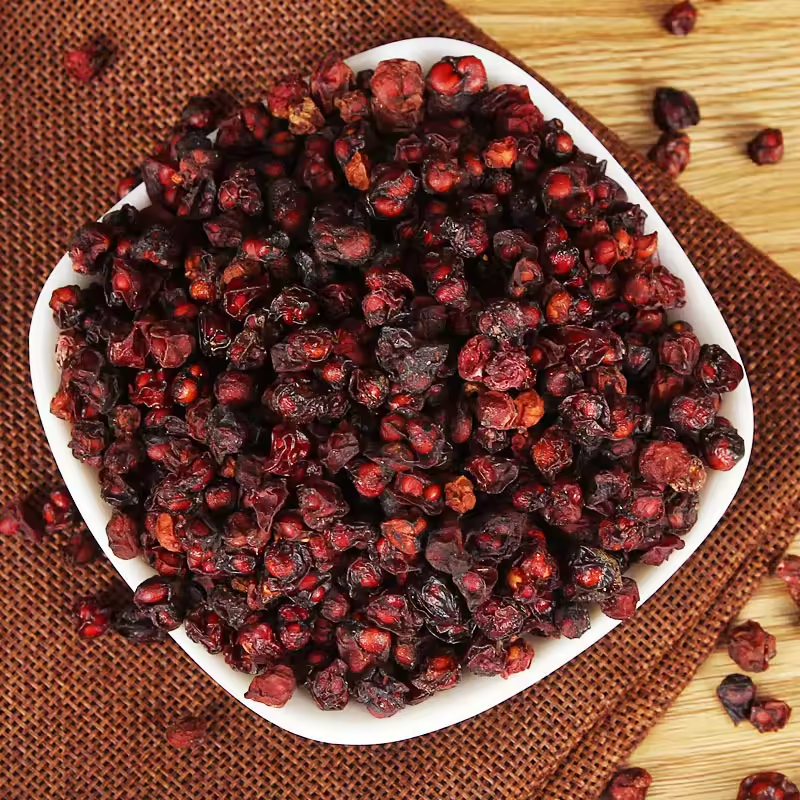



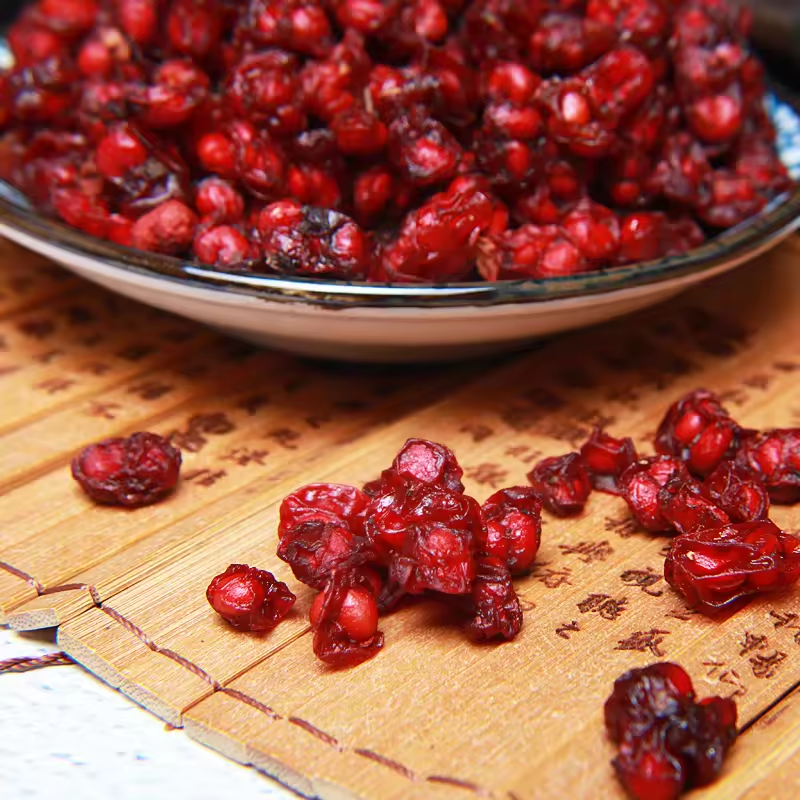
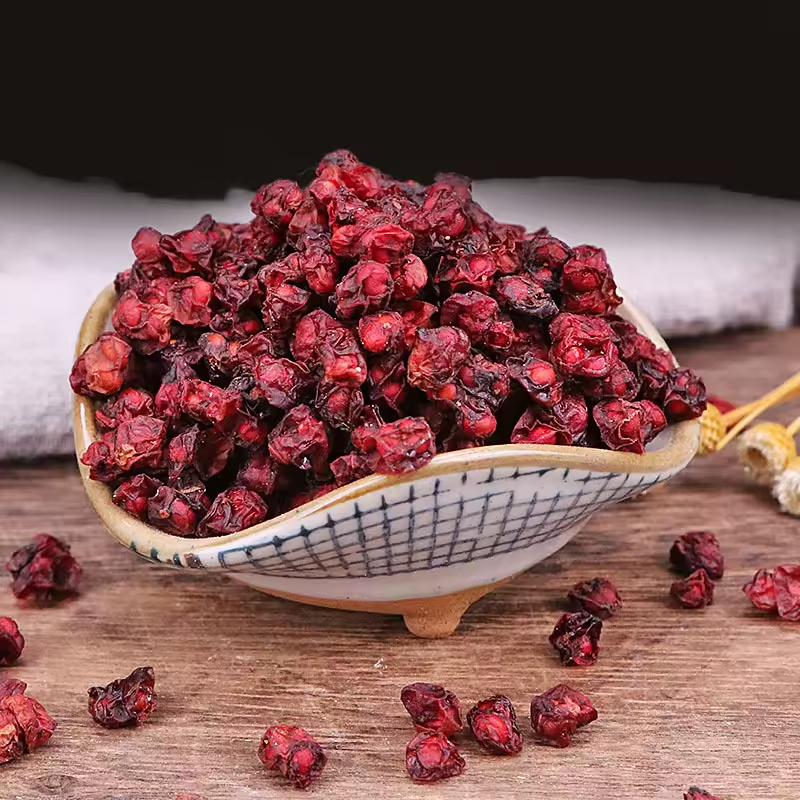


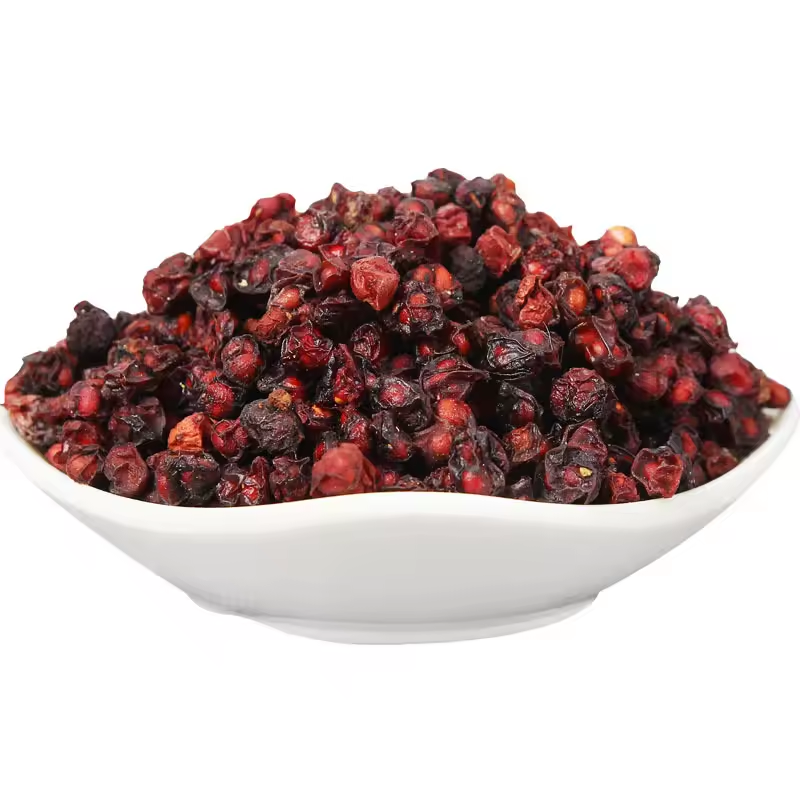
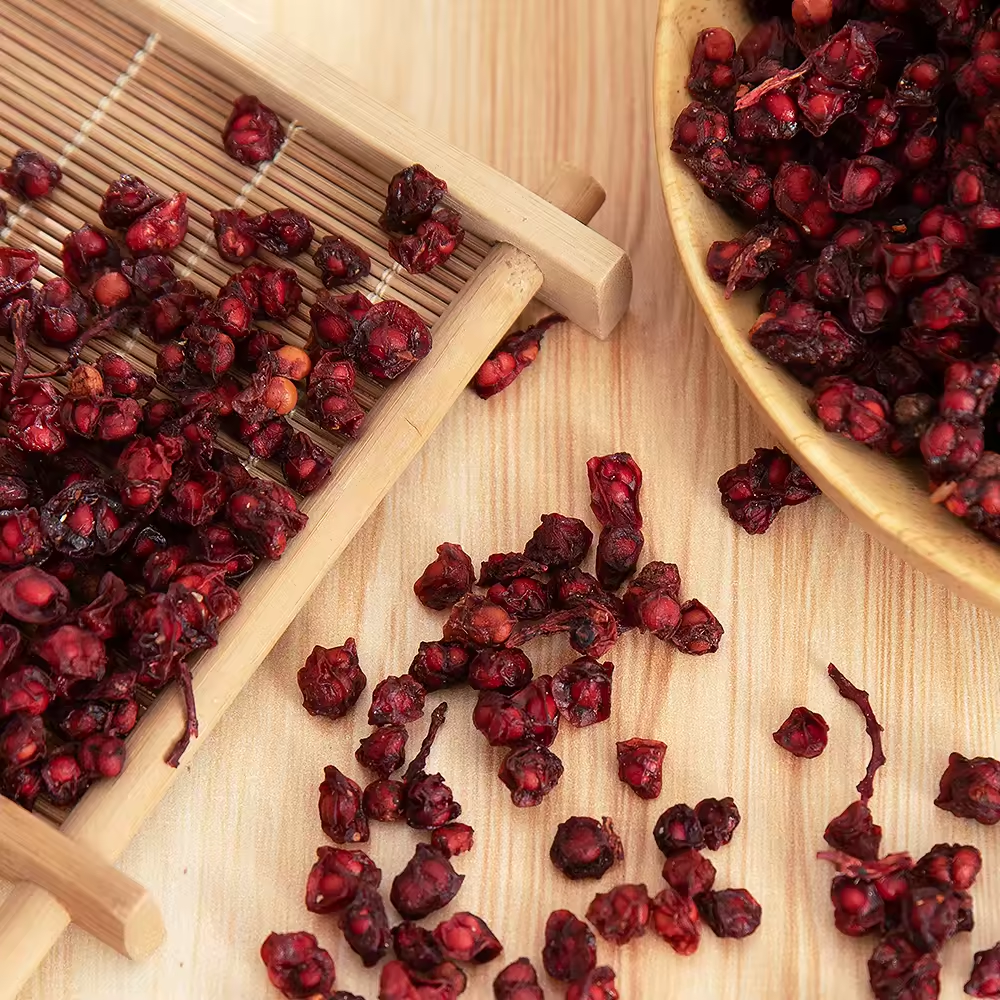



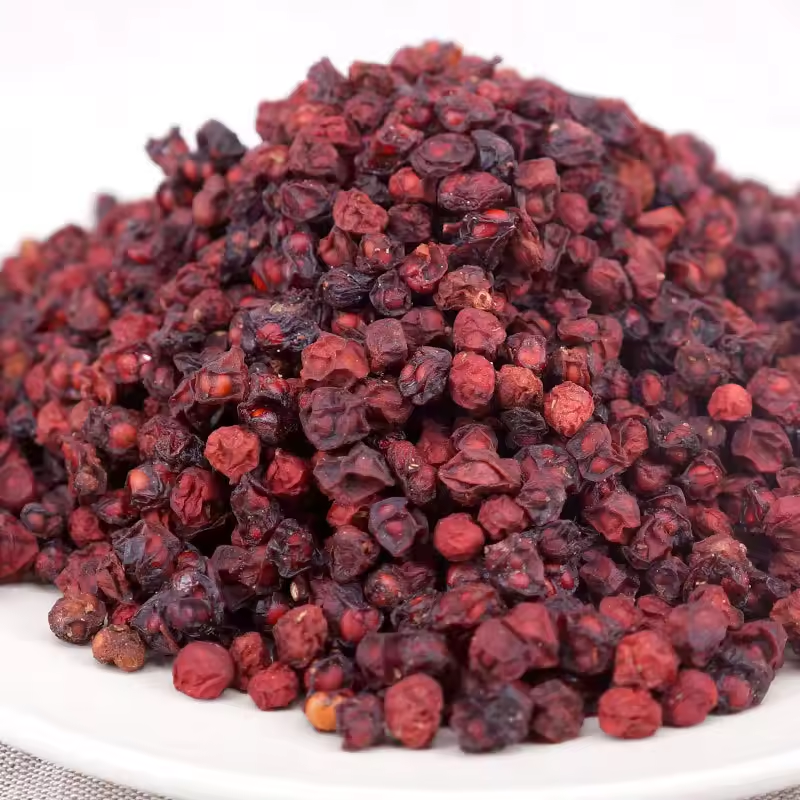
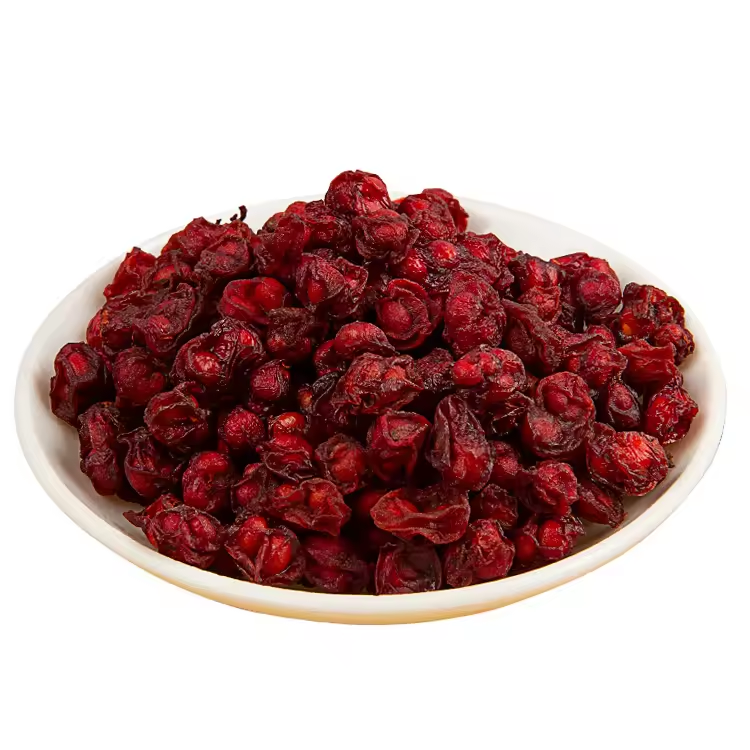

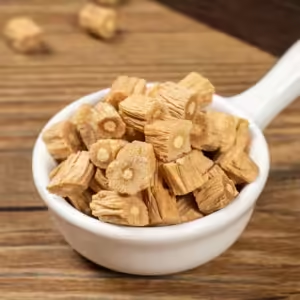
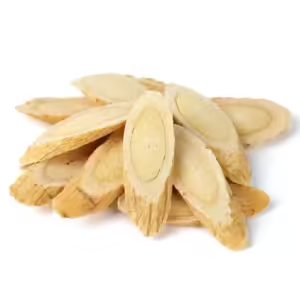
Avaliações
Ainda não existem avaliações.